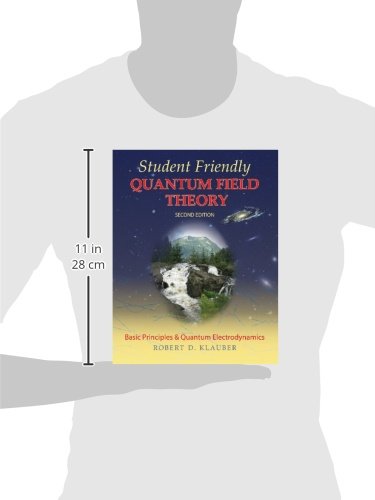



Student Friendly Quantum Field Theory: Volume 1: Basic Principles and Quantum Electrodynamics
U**S
If you're doing QFT on your own, a better text is almost inconceivable.
If you're reasonably familiar with basic "particle" quantum mechanics, Maxwell's equations, and special relativity, but would like to dive into our best theory of nature -- quantum field theory -- and you're doing it on your own, it's hard to conceive of a better textbook choice than this. I have never in my life experienced a text as patient, clear, rigorous, transparent (the pacing of reminders and intra-text cross-referencing is just brilliant), and relentlessly helpful as this one; on a topic that is about as profound and difficult as it gets.
S**A
The author truly has a gift for explaining QFT!
I am in my early 50's, with an undergraduate education in math and some physics, and have long tried to self-study QFT with limited success. The author's careful wording and patience toward the reader is truly remarkable! It is as if the author wrote the book using the technique of a method actor, "getting into character" of a student first learning QFT. Virtually all the questions and confusions that arise when first studying QFT are anticipated and patiently explained at each step.I have Peskin & Schroeder's, Zee's, Weinberg's and even McMahon's "QFT Demystified" book, yet none have so clearly connected my understanding with the concepts as this book. I particularly like they way the author takes the time, at each point, to explain how the QFT notions are related to prior Classical, Nonrelativistic QM and Relativistic QM concepts. This is done in the form of "Wholeness Charts" throughout the book to summarize, compare and contrast conceptually similar expressions in each theory.The author is careful to explain the spaces in which each term of an expression or equation live - e.g. spinor (non-physical) vs. 3D or 4D physical space, or abstract ket notation versus a representation of the ket on some basis. Alot of this might be glossed over in other texts, or it is just assumed the beginning reader can easily intuit or grasp these nuances as they are sifting through very terse mathematical expressions.The book provides carefully and completely worked real examples of actually using the theory. A complete solutions manual is sold separately but is vital to someone such as myself to self-learning the subject.This book is truly a joy to read! While other QFT books have left me frustrated and wondering whether I really can understand QFT (or whether 2+2=4 anymore!), this book leaves me both encouraged and enlightened.
T**Y
An Excellent Introductory Text
When attempting to tackle the subject of Quantum Field Theory, one is often met with texts that are of great difficulty. This is to be expected, since QFT is a difficult subject. However, students will take notice that formidable textbooks in many subjects are plagued with pedagogical difficulties. Such difficulties include lacking derivations of difficult results, poorly chosen and unenlightening exercises, trite dismissals of rather complicated deductive steps as being “obvious”, and deferring the responsibility of the derivations of central important facts of the subjects to readers.Klauber, in this textbook, attempts to rectify these problems, and largely succeeds at it. The central results of the book are very thoroughly derived, with little algebra skipped in the intermediary steps. The students are left free to actually use the central results on well-chosen exercises, instead of scratching their heads trying to understand just why it is that the central results are true in the first place. No step is arrogantly dismissed as “too obvious” to explicate, and the result is a much faster learning experience than a book which elevates brevity above completeness of treatment. The book is a godsend amongst not just QFT textbooks, but physics textbooks as a whole in terms of quality of pedagogy. If one wishes to begin a study in quantum field theory, look no further.Central to the success of this book is the philosophy of writing layed out by Klauber in the Preface to the book (available at http://www.quantumfieldtheory.info/Website_Preface.pdf for free). It is a wonderful piece and is quite good advice for anybody seeking to write student friendly expositions of any topic. In a nutshell, it is: avoid brevity, give holistic previews before examining details, include schematic diagram summaries of topics, give reviews of background material, include only core ideas (no peripheral subjects), include well-chosen exercises, chunk difficult concepts into many small steps, employ simple and concrete examples liberally, include marginal notes, emphasize definitions and key equations, and do not dismiss things as “obvious” or “trivial”.The only gripe that I have with the book is the large quantity of errata. However, the annoyance of the errors is far outweighed by the gains the book makes in explanatory power. A dedicated website is run on the book, and the author and other diligent readers are constantly working very hard to make explanations of difficult concepts even more clear. After this book or alongside it, I would also recommend Lancaster's “Quantum Field Theory for Gifted Amateurs” and Srednicki's book on QFT.
C**C
Student-friendly doesn't mean simplified
Although this book and its Volume 2 companion remain above my reading level for the time being, I did determine that if I ever were to improve my understanding of QFT at the "actual mathematical" level, this this would be the set to help with that.The superiority of the approach taken in these books is that the detailed explanations are sufficiently patient and complete that you can either follow them, or know exactly where you lost the thread (due to unfamiliar notation, reference to previous material, or whatever). Then you actually have a fighting chance to go off and clarify your understanding on that point before coming back to restart the thread. If this happens on page 3, then so be it. But you can still hold out hope.
Trustpilot
5 days ago
1 week ago